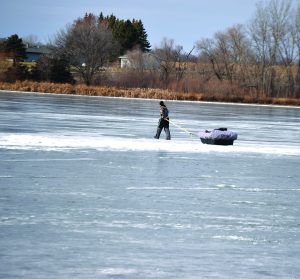Some are already venturing out on ice to fish
Published on December 4, 2023 at 12:18pm CST
Publisher’s Perspective
By Tim Douglass, Publisher of the Pope County Tribune
 The ice season started for some in the Pope County area on Friday and into the weekend with ice forming on most area lakes by Tuesday of last week. According to the DNR, there were numerous reports of ice anglers already testing their luck in our area and throughout the state.
The ice season started for some in the Pope County area on Friday and into the weekend with ice forming on most area lakes by Tuesday of last week. According to the DNR, there were numerous reports of ice anglers already testing their luck in our area and throughout the state.
I’m all for getting out there on early ice and I believe ice thickness is at about 4 inches in most areas where anglers have been trying their luck. But ice conditions this time of year are highly variable and can change quickly. Safety officials stress the importance of anyone heading onto the ice to check its thickness for themselves and not rely on other people’s footprints, tracks or social media posts.
I didn’t get close enough to anglers venturing out over the weekend to ask them about the ice thickness so this report is devoid of that information.
While 4 inches of new, clear ice is the minimum recommended thickness for walking, remember it takes at least 5 to 7 inches to hold a snowmobile or small all-terrain vehicle, 7 to 8 inches for a larger, side-by-side ATV, and 9 to 10 inches for a small car or SUV.
“The beginning of the ice season is always an exciting time for hardy Minnesotans, but it also can be deadly if you don’t take the proper safety precautions,” said Col. Rodmen Smith, director of the DNR Enforcement Division. “Checking the ice thickness regularly – and for yourself – is absolutely vital and one of the easiest ways to ensure tragedy doesn’t strike when you’re out there.”
Each year, unexpected falls through thin ice lead to serious injury or death. Checking the ice thickness with a spud bar, auger or other device is the best way to prevent falling through. Wearing a life jacket is the best way to avert tragedy, since the initial shock of falling into cold water can incapacitate even strong swimmers. A good set of ice picks can help someone get out of the water, and a cell phone, whistle or other communications device makes it more likely a person can call for help.
General ice safety guidelines
No ice can ever be considered “safe ice,” but following these guidelines (mndnr.gov/safety/ice/thickness.html) can help minimize the risk:
Always wear a life jacket or float coat on the ice (except when in a vehicle).
Carry ice picks, rope, an ice chisel and tape measure.
Check ice thickness at regular intervals; conditions can change quickly.
Bring a cell phone or personal locator beacon.
Don’t go out alone; let someone know about trip plans and expected return time.
Before heading out, inquire about conditions and known hazards with local experts.
Parents and guardians should talk with their children and neighborhood children about staying away from the ice unless there’s adult supervision. This includes lakes and rivers, as well as neighborhood ponds, retention ponds and anywhere ice forms.




